ESD CAN-PCIe/400 2 or 4 Channel PCI Express CAN Interface Board Owner's manual
- Type
- Owner's manual

CAN-PCIe/400
PCI Express CAN Interface
Hardware Manual
to Product C.2043.04, C.2043.06
CAN-PCIe/400 Hardware Manual • Doc. No.: C.2043.21 / Rev. 1.1 Page 1 of 28
esd electronic system design gmbh
Vahrenwalder Str. 207 • 30165 Hannover • Germany
http://www.esd.eu
Phone: +49 (0) 511 3 72 98-0 • Fax: +49 (0) 511 3 72 98-68

N O T E
The information in this document has been carefully checked and is believed to be entirely reliable.
esd makes no warranty of any kind with regard to the material in this document, and assumes no
responsibility for any errors that may appear in this document. In particular descriptions and
technical data specified in this document may not be constituted to be guaranteed product features
in any legal sense.
esd reserves the right to make changes without notice to this, or any of its products, to improve
reliability, performance or design.
All rights to this documentation are reserved by esd. Distribution to third parties, and reproduction
of this document in any form, whole or in part, are subject to esd's written approval.
© 2015 esd electronic system design gmbh, Hannover
esd electronic system design gmbh
Vahrenwalder Str. 207
30165 Hannover
Germany
Phone: +49-511-372 98-0
Fax: +49-511-372 98-68
E-Mail: [email protected]
Internet: www.esd.eu
Trademark Notices
CANopen® and CiA® are registered community trademarks of CAN in Automation e.V.
Windows is a registered trademark of Microsoft Corporation in the United States and other countries.
The PICMG® name and logo are registered trademarks of the PCI Industrial Computer Manufacturers Group.
All other trademarks, product names, company names or company logos used in this manual are reserved by their
respective owners.
Page 2 of 28 Hardware Manual • Doc. No.: C.2043.21 / Rev. 1.1 CAN-PCIe/400

Document file: I:\Texte\Doku\MANUALS\CAN\PCI-Express\CAN-PCIe400_(PEX3000)\Englisch\CAN-
PCIe400_Hardware_en_11.odt
Date of print: 2015-04-30
Document type
number: DOC0800
Hardware version: CAN-PCI/400 Rev. 1.0
Document History
The changes in the document listed below affect changes in the hardware as well as changes in
the description of the facts, only.
Revision Chapter Changes versus previous version Date
1.0 - First English version. 2012-03-20
1.1
4.2 Correction of link width
2015-04-30
4.4 Chapter “Software Support” revised
6. Chapter “Correctly Wiring” revised
8. Declaration of Conformity updated
9. Order information revised
Technical details are subject to change without further notice.
CAN-PCIe/400 Hardware Manual • Doc. No.: C.2043.21 / Rev. 1.1 Page 3 of 28

Safety Instructions
!When working with CAN-PCIe/400 follow the instructions below and read the manual carefully to protect
yourself from injury and the CAN-PCIe/400 from damage.
!The device is a built-in component. It is essential to ensure that the device is mounted in a way that
cannot lead to endangering or injury of persons or damage to objects.
!The device has to be securely installed in the control cabinet before commissioning.
!Protect the CAN-PCIe/400 from dust, moisture and steam.
!Protect the CAN-PCIe/400 from shocks and vibrations.
!The CAN-PCIe/400 may become warm during normal use. Always allow adequate ventilation around the
CAN-PCIe/400 and use care when handling.
!Do not operate the CAN-PCIe/400 adjacent to heat sources and do not expose it to unnecessary thermal
radiation. Ensure an ambient temperature as specified in the technical data.
!Do not use damaged or defective cables to connect the CAN-PCIe/400 and follow the CAN wiring hints in
chapter: "Correctly Wiring Electrically Isolated CAN Networks".
!In case of damages to the device, which might affect safety, appropriate and immediate measures must
be taken, that exclude an endangerment of persons and domestic animals and property.
!Current circuits which are connected to the device have to be sufficiently protected against hazardous
voltage (SELV according to EN 60950-1).
!The CAN-PCIe/400 may only be driven by power supply current circuits, that are contact protected.
A power supply, that provides a safety extra-low voltage (SELV or PELV) according to EN 60950-1,
complies with this conditions.
Attention !
Electrostatic discharges may cause damage to electronic components.
To avoid this, please perform the steps described on page 8 before you touch the CAN-
PCIe/400, in order to discharge the static electricity from your body.
Qualified Personal
This documentation is directed exclusively towards personal qualified in control and automation engineering.
The installation and commissioning of the product may only be carried out by qualified personal, which is
authorized to put devices, systems and electric circuits into operation according to the applicable national
standards of safety engineering.
Conformity
The CAN-PCIe/400-2 meets the demands of the EU regulations and EMC standards printed in the
conformity declaration at the end of this manual.
Intended Use
The intended use of the CAN-PCIe/400 is the operation as a PCI Express CAN interface for PCs.
The guarantee given by esd does not cover damages which result from improper use, usage not in
accordance with regulations or disregard of safety instructions and warnings.
!The CAN-PCIe/400 is intended for installation in a PCI Express slot of an industrial or home computer
only.
!The operation of the CAN-PCIe/400 in hazardous areas, or areas exposed to potentially explosive
materials is not permitted.
!The operation of the CAN-PCIe/400 for medical purposes is prohibited.
Service Note
The CAN-PCIe/400 does not contain any parts that require maintenance by the user. The CAN-PCIe/400
does not require any manual configuration of the hardware.
Disposal
Devices which have become defective in the long run have to be disposed in an appropriate way or have to
be returned to the manufacturer for proper disposal. Please, make a contribution to environmental protection.
Page 4 of 28 Hardware Manual • Doc. No.: C.2043.21 / Rev. 1.1 CAN-PCIe/400

Table of contents
1. Overview...................................................................................................................................... 6
1.1 Description of the Module......................................................................................................6
1.2 PCB View with Connectors....................................................................................................7
2. Hardware Installation....................................................................................................................8
2.1 CAN-PCIe/400-4 Version with 4 CAN Interfaces..................................................................10
3. Front Panel View with LED-Display............................................................................................11
3.1 Additional LEDs on CAN-PCIe/400-4 Adapter Board...........................................................12
4. Technical Data...........................................................................................................................13
4.1 General Technical Data.......................................................................................................13
4.2 PCI Express Interface..........................................................................................................13
4.3 CAN Interface......................................................................................................................14
4.4 Software Support.................................................................................................................14
5. Connector Assignments.............................................................................................................15
5.1 CAN.....................................................................................................................................15
6. Correctly Wiring Electrically Isolated CAN Networks..................................................................16
6.1 Standards concerning CAN Wiring......................................................................................16
6.2 Light Industrial Environment (Single Twisted Pair Cable).....................................................17
6.2.1 General Rules.............................................................................................................17
6.2.2 Cabling........................................................................................................................18
6.2.3 Termination.................................................................................................................18
6.3 Heavy Industrial Environment (Double Twisted Pair Cable).................................................19
6.3.1 General Rules.............................................................................................................19
6.3.2 Device Cabling............................................................................................................20
6.3.3 Termination.................................................................................................................20
6.4 Electrical Grounding.............................................................................................................21
6.5 Bus Length...........................................................................................................................21
6.6 Examples for CAN Cables...................................................................................................22
6.6.1 Cable for light industrial Environment Applications (Two-Wire)...................................22
6.6.2 Cable for heavy industrial Environment Applications (Four-Wire)................................22
7. CAN Troubleshooting Guide.......................................................................................................23
7.1 Termination..........................................................................................................................23
7.2 Electrical Grounding.............................................................................................................24
7.3 Short Circuit in CAN Wiring..................................................................................................24
7.4 CAN_H/CAN_L-Voltage ......................................................................................................24
7.5 CAN Transceiver Resistance Test.......................................................................................25
7.6 Support by esd.....................................................................................................................25
8. Declaration of Conformity...........................................................................................................26
9. Order Information.......................................................................................................................27
CAN-PCIe/400 Hardware Manual • Doc. No.: C.2043.21 / Rev. 1.1 Page 5 of 28

Overview
1. Overview
1.1 Description of the Module
Figure 1: Block circuit diagram of CAN-PCIe/400
The CAN-PCIe/400 is a PC board designed for the PCI Express® bus that features two (CAN-
PCIe/400-2) or optionally four (CAN-PCIe/400-4) electrically isolated high-speed CAN interfaces
according to ISO 11898-2. CAN-PCIe/400-4 comes with two additional CAN interfaces via a
separate slot bracket.
The independent CAN nets designed acc. to ISO 11898-1 are driven by the esdACC (esd
Advanced CAN Core) implemented in the Xilinx® Spartan® 3e FPGA.
Controlled by the FPGA the CAN-PCIe/400 supports bus mastering as an initiator, meaning that it
is capable of initiating write cycles to the host CPU’s RAM independent of the CPU or the system
DMA controller. This results in a reduction of overall latency on servicing I/O transactions in
particular at higher data rates and reduced host CPU load.
The CAN-PCIe/400 provides high resolution hardware timestamps.
CAN Error injection on request.
CAN layer 2 (CAN-API) software drivers are available for Windows®, Linux®, VxWorks®, QNX®,
RTX and On Time RTOS-32. The CANopen® software package is available for Windows, Linux,
VxWorks and QNX.
Drivers for other operating systems are available on request.
Page 6 of 28 Hardware Manual • Doc. No.: C.2043.21 / Rev. 1.1 CAN-PCIe/400
FPGA
Xilinx Spartan-3E
(32-Bit Microcontroller
MicroBlaze Option)
PCI Bridge
Pex 8311
RAM
(Option)
C
A
N
B
U
S
DC/DC
Converter
Physical
CAN
Layer
C
A
N
B
U
S
DC/DC
Converter
Physical
CAN
Layer
CAN2
CAN3
CAN0
CAN1
DSUB9
CiA pinning
DSUB9
CiA pinning
4 x
CAN Core
with Timestamp
PCIe
Card Edge
Connector
Adapter Board (CAN-PCIe/400-4 only)
Option
10-pole
post connector
CAN-adapter board
Electrical Isolation
Electrical Isolation
Ribbon
Cable

Hardware Installation
2. Hardware Installation
Read the safety instructions at the beginning of this document carefully,
before you start with the hardware installation!
Danger!
Electric shock risk. Never carry out work while power supply voltage is switched on!
Attention !
Electrostatic discharges may cause damage to electronic components. To avoid
this, please discharge the static electricity from your body by touching the metal
case of the PCI Express system before you touch the CAN-PCIe/400.
Procedure:
1. Switch off your computer and all connected peripheral devices (monitor, printer, etc.). Switch
off the connected CAN devices.
2. Discharge your body as described above.
3. Disconnect the power supply of the PC from the mains.
If the computer does not have a flexible mains cable, but is directly connected to mains,
disconnect the power supply via the safety fuse and make sure that the fuse cannot switch
on again unintentionally (i.e. with caution label).
Danger!
Never carry out work while power supply voltage is switched on!
4. Open the case.
5. Select an open PCI Express slot and remove the slot cover at the back of the PC.
The CAN module can be inserted into every PCI Express slot.
Be careful not to insert the board into an ISA slot, because this can damage the PC and the
board!
6. Insert the CAN-PCIe/400 board into the selected PCI Express slot. Carefully push the board
down until it snaps into place.
7. Attach the board.
8. If you are installing the CAN-PCIe/400-4 module with 4 CAN interfaces you have to install the
adapter board in the PCI Express slot next to the CAN-PCIe/400 board. Connect the two
boards with the included ribbon cable (see figure 3 on page 10) via the 10-pin post
connectors on the bard and on the adapter.
9. Close the computer case again.
10. Connect the CAN wire.
Please note that the CAN bus has to be terminated at both ends!
esd offers special T-connectors and termination connectors. Additionally the CAN_GND
signal has to be connected to earth at exactly one point. Read chapter “Correctly Wiring
Electrically Isolated CAN Networks” on page 16 for detailed information.
A CAN participant without an electrically isolated interface acts as an earth connection.
Page 8 of 28 Hardware Manual • Doc. No.: C.2043.21 / Rev. 1.1 CAN-PCIe/400

Hardware Installation
The first CAN interface (CAN 0) has to be connected via the lower DSUB connector (X400)
and the second CAN interface (CAN 1) has to be connected via the upper DSUB connector
(X410).
If you are installing a CAN-PCIe/400-4 with four CAN interfaces, you have to connect the
third CAN interface via the lower DSUB connector of the adapter board and the fourth CAN
interface via the upper DSUB connector of the adapter board. You will find a figure showing
the connectors on page 10.
11. Connect the computer to mains again (mains connector or fuse).
12. Switch on the computer and the peripheral devices.
13. End of hardware installation.
Continue with the software installation as described in the manual ‘CAN-API, Installation
Guide’.
CAN-PCIe/400 Hardware Manual • Doc. No.: C.2043.21 / Rev. 1.1 Page 9 of 28

Hardware Installation
2.1 CAN-PCIe/400-4 Version with 4 CAN Interfaces
Figure 3: View of CAN-PCIe/400-4 with ribbon cable
In the CAN-PCIe/400-4 version, the board comes with four CAN interfaces.
This module type uses two additional CAN transcievers. The physical layer of the additional CAN
interfaces is placed on a separate adapter board. The adapter board has to be mounted close to
the CAN-PCIe/400. Furthermore, it has to be connected via the ribbon cable that is contained in
the scope of delivery.
The two additional physical interfaces are designed identical to the physical interfaces of CAN0
and CAN1.
Page 10 of 28 Hardware Manual • Doc. No.: C.2043.21 / Rev. 1.1 CAN-PCIe/400

Front Panel View with LED-Display
3. Front Panel View with LED-Display
The CAN-PCIe/400-2 is equipped with four green LEDs in the front panel.
Figure 4: Front panel view ( CAN-PCIe/400-2)
Label Name Indicator
State Description
LED name
in schematic
diagram
ATraffic
CAN0
off no CAN bus connection and/or no CAN traffic on CAN0 D300A
on connected to CAN bus 0 and CAN traffic on CAN0
BTraffic
CAN1
off no CAN bus connection and/or no CAN traffic on CAN1 D300B
on connected to CAN bus 1 and CAN traffic on CAN1
Creserved - - D300C
DPower off power supply voltage off D300D
on power supply voltage on
Table 1: LEDs
CAN-PCIe/400 Hardware Manual • Doc. No.: C.2043.21 / Rev. 1.1 Page 11 of 28

Front Panel View with LED-Display
3.1 Additional LEDs on CAN-PCIe/400-4 Adapter Board
The CAN-PCIe/400-4 is equipped with four LEDs as described in table 1 and with four additional
green LEDs in the front panel of the adapter board.
Label Name Indicator
State Description
ATraffic
CAN2
off no CAN bus connection and/or no CAN traffic on CAN2
on connected to CAN bus 2 and CAN traffic on CAN2
BTraffic
CAN3
off no CAN bus connection and/or no CAN traffic on CAN3
on connected to CAN bus 3 and CAN traffic on CAN3
Creserved - -
DPower off power supply voltage off
on power supply voltage on
Table 2: Additional LEDs on adapter board
Page 12 of 28 Hardware Manual • Doc. No.: C.2043.21 / Rev. 1.1 CAN-PCIe/400

Technical Data
4. Technical Data
4.1 General Technical Data
Ambient
temperature 0...50°C
Humidity 90 %, non-condensing
Supply voltage 3.3 V ±5% / (depending on FPGA-image, 2x CAN: up to I = 1 A)
12 V ±5% / Itypically = 100 mA
Plug- and socket
connectors
CAN0 - CAN interface 0 (9-pin DSUB/male, X400)
CAN1 - CAN interface 1 (9-pin DSUB/male, X410)
PCIe - (card edge connector, X100)
X420 - connection to adapter board via ribbon cable
(10-pin post connector)
Only for test- and programming purposes:
X430 - future use
X700 - future use
Additional connectors equipped on CAN-PCIe/400-4 adapter board:
CAN0 - CAN interface 0 (9-pin DSUB/male)
CAN1 - CAN interface 1 (9-pin DSUB/male)
X420 - connection to CAN-PCIe/400 board via ribbon cable
(10-pin post connector)
LEDs CAN traffic, Power
Dimensions 105 mm x 111 mm (board only)
CAN-PCIe/400-4 only: adapter board: 107 mm x 55 mm (board only)
Weight CAN-PCIe/400-2: 100 g
CAN-PCIe/400-4: 165 g
Table 3: General technical data of the module
4.2 PCI Express Interface
PCIe endpoint PLX PEX8311
PCIe port according to PCI Express Specification R1.0a, Link width 1x
Memory BlockRAM: 72 KB, DDR-SDRAM:64 MB
Connector PCI-card edge connector
Table 4: PCI bus data
CAN-PCIe/400 Hardware Manual • Doc. No.: C.2043.21 / Rev. 1.1 Page 13 of 28

Technical Data
4.3 CAN Interface
Number of CAN
interfaces
CAN-PCIe/400-2: 2 CAN high-speed interfaces (CAN0, CAN1)
CAN-PCIe/400-4: 4 CAN high-speed interfaces (CAN0 - CAN3)
CAN controller esdACC in FPGA Spartan® 3e,
according to ISO11898-1 (CAN 2.0A/2.0B)
CAN protocol according to ISO11898-1
Physical Layer physical layer according to ISO 11898-2,
bit rate up to 1 Mbit/s
Bus termination terminating resistor has to be set externally, if required
Electrical isolation via digital isolator and DC/DC-converters
Connector CAN-PCIe/400-2 (2x CAN): 2x DSUB9 (male)
CAN-PCIe/400-4 (4x CAN): 4x DSUB9 (male)
Table 5: Data of the CAN interface
4.4 Software Support
CAN layer 2 (CAN-API) software drivers are available for Windows®, Linux®, VxWorks®, QNX®,
RTX, RTX64 and On Time RTOS-32.
The CANopen® software package is available for Windows, Linux, VxWorks, and QNX.
Drivers for other operating systems are available on request.
For detailed information about the driver availability for your operating system, please contact our
sales team: [email protected]
The CAN layer 2 (CAN-API) software installation and the software drivers are described in the
manual:
“NTCAN-API Part 1: Structure, Function and C/C++ API” Application Developers Manual and
“NTCAN-API Part 2: Installation, Configuration and Firmware Update” Installation Guide
esd-order No.: C.2001.21
Page 14 of 28 Hardware Manual • Doc. No.: C.2043.21 / Rev. 1.1 CAN-PCIe/400

Connector Assignments
5. Connector Assignments
5.1 CAN
The signal assignments of CAN 0 and CAN 1 and both additional CAN interfaces (CAN-PCIe/400-
4 only) are identical.
Device connector: 9-pin DSUB connector, male
Pin Position:
Pin Assignment:
Signal Pin Signal
1
reserved
(CANx_GND)
6
2
CANx_L
CANx_H
7
3
CANx_GND
reserved
8
4
reserved
reserved
9
5
Shield
Signal Description:
CANx_L, CANx_H ... CAN signal lines of CAN net x (CAN-PCIe/400-2: x ... 0,1,
CAN-PCIe/400-4: x ... 0 - 3)
CANx_GND ... reference potential of the local CAN physical layer x
(CANx_GND)... optional reference potential of the local CAN physical layer
Shield ... shielding (connected with the case of the 9-pin DSUB connector)
reserved ... reserved for future applications, do not connect!
CAN-PCIe/400 Hardware Manual • Doc. No.: C.2043.21 / Rev. 1.1 Page 15 of 28
12345
6789

Correctly Wiring Electrically Isolated CAN Networks
6. Correctly Wiring Electrically Isolated CAN Networks
For the CAN wiring all applicable rules and regulations (EU, DIN), e.g. regarding electromagnetic
compatibility, security distances, cable cross-section or material, have to be observed.
6.1 Standards concerning CAN Wiring
The flexibility in CAN network design is one of the key strengths of the various extensions and
additional standards like e.g. CANopen, ARINC825, DeviceNet and NMEA2000 that have been
built on the original ISO 11898-2 CAN standard. In using this flexibility comes the responsibility of
good network design and balancing these tradeoffs.
Many CAN organizations and standards have scaled the use of CAN for applications outside the
original ISO 11898. They have made system level tradeoffs for data rate, cable length, and
parasitic loading of the bus.
However for CAN network design margin must be given for signal loss across the complete system
and cabling, parasitic loadings, network imbalances, ground offsets against earth potential and
signal integrity. Therefore the practical maximum number of nodes, bus length and stub
length are typically much lower.
esd has concentrated her recommendations concerning CAN wiring on the specifications of the
ISO 11898-2. Thus this wiring hints forgoes to describe the special features of the derived
standards CANopen, ARINC825, DeviceNet and NMEA2000.
The consistent compliance to ISO 11898-2 offers significant advantages:
●Durable operation due to well proven design specifications
●Minimizing potential failures due to sufficient margin to physical limits
●Trouble-free maintenance during future network modifications or during fault diagnostics
due to lack of exceptions
Of course reliable networks can be designed according the specifications of CANopen, ARINC825,
DeviceNet and NMEA2000, however it must be observed that it is strictly not recommended
to mix the wiring guidelines of the various specifications!
Page 16 of 28 Hardware Manual • Doc. No.: C.2043.21 / Rev. 1.1 CAN-PCIe/400

Correctly Wiring Electrically Isolated CAN Networks
6.2 Light Industrial Environment (Single Twisted Pair Cable)
6.2.1 General Rules
Note:
esd grants the EU Conformity of the product, if the CAN wiring is carried out with at
least single shielded single twisted pair cables that match the requirements of
ISO 11898-2. Single shielded double twisted pair cable wiring as described in chapter
6.3. ensures the EU Conformity as well.
The following general rules for CAN wiring with single shielded single twisted pair cable should be
followed:
1A cable type with a wave impedance of about 120 Ω ±10% with an adequate conductor cross-section
(≥ 0.22 mm²) has to be used. The voltage drop over the wire has to be considered.
2For light industrial environment use at least a two-wire CAN cable.
Connect
•
•
the two twisted wires to the data signals (CAN_H, CAN_L) and
the cable shield to the reference potential (CAN_GND).
3The reference potential CAN_GND has to be connected to the functional earth (FE) at exactly one
point.
4A CAN net must not branch (exception: short cable stubs) and has to be terminated with the
characteristic impedance of the line (generally 120 Ω ±10%) at both ends (between the signals CAN_L
and CAN_H and not at CAN_GND).
5Keep cable stubs as short as possible (l < 0.3 m).
6Select a working combination of bit rate and cable length.
7Keep away cables from disturbing sources. If this cannot be avoided, double shielded wires are
recommended.
Figure 5: CAN wiring for light industrial environment
CAN-PCIe/400 Hardware Manual • Doc. No.: C.2043.21 / Rev. 1.1 Page 17 of 28
CAN GND
CAN_H
CAN_GND
n.c.
CAN_L 1
4
5
6
7
9
2
3
8
9
1
4
5
6
7
3
8
2
n.c.
n.c.
n.c.
n.c.
n.c.
n.c.
n.c.
n.c.
n.c.
n.c.
n.c.
n.c.
n.c.
earth (FE)
CAN_L
CAN_H
CAN_GND
Single shielded
twisted pair cable
(two-wire cable,
1x 2x 0.22mm²)
CAN_GND
(at wire shield)
Wire Layout
Signal assignment of single shielded twisted pair cable
with earth and termination
n.c. = not connected
DSUB9 connector
(female or male)
pin designation
connector case connector case
DSUB9 connector
(female or male)
pin designation
CAN wire with connectors

Correctly Wiring Electrically Isolated CAN Networks
6.2.2 Cabling
●To connect CAN devices with just one CAN connector per net use a short stub (< 0.3 m)
and a T-connector (available as accessory). If this devices are located at the end of the
CAN network, the CAN terminator “CAN-Termination-DSUB9” can be used.
Figure 6: Example for proper wiring with single shielded single twisted pair wires
6.2.3 Termination
●A termination resistor has to be connected at both ends of the CAN bus.
If an integrated CAN termination resistor which is equipped at the CAN interface at the end
of the bus is connected, this one has to be used for termination instead of an external CAN
termination plug.
●9-pin DSUB-termination connectors with integrated termination resistor and male and
female contacts (gender changer) are available from esd (order no. C.1303.01).
●DSUB termination connectors with male contacts (order no. C.1302.01) or female contacts
(order no. C.1301.01) and additional functional earth contact are available, if CAN
termination and grounding of CAN_GND is required.
Page 18 of 28 Hardware Manual • Doc. No.: C.2043.21 / Rev. 1.1 CAN-PCIe/400
CAN_L
CAN_GND
CAN_H
FE
CAN-DP/2CAN-CBX-DIO8 CAN-CBX-AI420
l
< 0,3 m
l
< 0,3 m
l
< 0,3 m
Female Connector
Male Connector
Terminator
with FE connector
Female Terminator
(Order-no.: C.1301.01)
T-Connector
C.1311.03
CAN cable
Order-no.: C.1323.03
CAN 0
CAN 1 T-Connector
C.1311.03
T-Connector
C.1311.03
CAN Board
CAN cable
Order-no.: C.1323.03
CAN cable
Order-no.: C.1323.03
Termination connector
"CAN-Termination-DSUB"
Order-no.: C.1303.01
Termination connector
"CAN-Termination-DSUB"
with femal and male contacts
(Order-no.: C.1303.01)
e.g.
CAN-PCIe/402,
PMC-CAN/400,
CAN-USB/2, etc.
CAN_GND connected
to functional earth (FE)
at exactly one point

Correctly Wiring Electrically Isolated CAN Networks
6.3 Heavy Industrial Environment (Double Twisted Pair Cable)
6.3.1 General Rules
The following general rules for the CAN wiring with single shielded double twisted pair cable
should be followed:
1A cable type with a wave impedance of about 120 Ω ±10% with an adequate conductor cross-section
(≥ 0.22 mm²) has to be used. The voltage drop over the wire has to be considered.
2For heavy industrial environment use a four-wire CAN cable.
Connect
•
•
•
two twisted wires to the data signals (CAN_H, CAN_L) and
the other two twisted wires to the reference potential (CAN_GND) and
the cable shield to functional earth (FE) at least at one point.
3The reference potential CAN_GND has to be connected to the functional earth (FE) at exactly one
point.
4A CAN bus line must not branch (exception: short cable stubs) and has to be terminated with the
characteristic impedance of the line (generally 120 Ω ±10%) at both ends (between the signals CAN_L
and CAN_H and not to CAN_GND).
5Keep cable stubs as short as possible (l < 0.3 m).
6Select a working combination of bit rate and cable length.
7Keep away CAN cables from disturbing sources. If this can not be avoided, double shielded cables are
recommended.
Figure 7: CAN wiring for heavy industrial environment
CAN-PCIe/400 Hardware Manual • Doc. No.: C.2043.21 / Rev. 1.1 Page 19 of 28
CAN GND
CAN_L
CAN_H
CAN_GND
n.c.
n.c.
n.c.
n.c.
n.c.
n.c.
n.c.
n.c.
n.c.
n.c.
CAN_L
CAN_H CAN_GND
Shield
CAN_GND
twisted twisted
5
6
7
9
8
1
4
3
2
9
1
4
5
6
7
3
8
2
n.c.
n.c.
Single shielded
double twisted pair cable
(four-wire cable,
2x 2x 0.22mm²)
wire shield
Wire Layout
(Example)
Signal assignment of single shielded double twisted pair cable
with earth and termination
n.c. = not connected
DSUB9 connector
(female or male)
pin designation
connector case
DSUB9 connector
(female or male)
pin designation
CAN cable with connectors
connector case
earth (FE)

Correctly Wiring Electrically Isolated CAN Networks
6.3.2 Device Cabling
Attention:
If single shielded double twisted pair cables are used, realize the T-connections by
means of connectors that support connection of two CAN cables at one connector
where the cable’s shield is looped through e.g. DSUB9 connector from ERNI (ERBIC
CAN BUS MAX, order no.:154039).
The usage of esd’s T-connector type C.1311.03 is not recommended for single
shielded double twisted pair cables because the shield potential of the conductive
DSUB housing is not looped through this T-connector type.
If a mixed application of single twisted and double twisted cables is unavoidable, take
care that the CAN_GND line is not interrupted!
Figure 8: Example of proper wiring with single shielded double twisted pair cables
6.3.3 Termination
●A termination resistor has to be connected at both ends of the CAN bus.
If an integrated CAN termination resistor which is equipped at the CAN interface at the end
of the bus is connected, this one has to be used for termination instead of an external CAN
termination plug.
●9-pin DSUB-termination connectors with integrated termination resistor and male and
female contacts (gender changer) are available from esd (order no. C.1303.01).
●9-pin DSUB-connectors with integrated switchable termination resistor can be ordered e.g.
from ERNI (ERBIC CAN BUS MAX, female contacts, order no.:154039).
Page 20 of 28 Hardware Manual • Doc. No.: C.2043.21 / Rev. 1.1 CAN-PCIe/400
CAN_L
CAN_GND
CAN_H
FE
CAN-CBX-DIO8
l
< 0,3 m
CAN-CBX-DIO8
l
< 0,3 m
CAN-DP/2
l
< 0,3 m
CAN_GND connected
to functional earth (FE)
at exactly one point
Net 2
Net 1
CAN Board
termination
switched OFF
CAN T-Connector
(DSUB9 connector, female),
with switchable termination
CAN
T-Connector
connected to earth (FE)
via computer housing
termination
switched OFF
CAN
T-Connector
termination
switched
ON
Attention:
Watch for the correct position of the
termination switches at the connectors!
CAN
T-Connector
e.g.
CAN-PCIe/402,
PMC-CAN/400,
CAN-USB/2, etc.
Female Connector
Male Connector
Termination connector "CAN-Termination-DSUB"
with femal and male contacts
(Order-no.: C.1303.01)
Shield
CAN cable
Order-no.: C.1323.03
CAN cable
Order-no.: C.1323.03
CAN cable
Order-no.: C.1323.03
Termination connector
"CAN-Termination-DSUB"
Order-no.: C.1303.01
Page is loading ...
Page is loading ...
Page is loading ...
Page is loading ...
Page is loading ...
Page is loading ...
Page is loading ...
Page is loading ...
-
 1
1
-
 2
2
-
 3
3
-
 4
4
-
 5
5
-
 6
6
-
 7
7
-
 8
8
-
 9
9
-
 10
10
-
 11
11
-
 12
12
-
 13
13
-
 14
14
-
 15
15
-
 16
16
-
 17
17
-
 18
18
-
 19
19
-
 20
20
-
 21
21
-
 22
22
-
 23
23
-
 24
24
-
 25
25
-
 26
26
-
 27
27
-
 28
28
ESD CAN-PCIe/400 2 or 4 Channel PCI Express CAN Interface Board Owner's manual
- Type
- Owner's manual
Ask a question and I''ll find the answer in the document
Finding information in a document is now easier with AI
Related papers
-
ESD CPCI-CAN/402-4(-FD) CompactPCI® Board Owner's manual
-
ESD CAN-USB-Mini Owner's manual
-
ESD CAN-M.2/402-2-FD M.2 Card Owner's manual
-
ESD CAN-Termination Owner's manual
-
ESD CAN-PCI/402 1, 2 or 4 Channel PCI-CAN Interface Owner's manual
-
ESD CPCI-CAN/400 Owner's manual
-
ESD CAN-PCI/266 PCI-CAN Interface Owner's manual
-
ESD C.2020.05 Owner's manual
-
ESD CAN-Repeater Passive I- and Y-Repeater Owner's manual
-
ESD EPPC-405-UC Owner's manual
Other documents
-
Schneider Electric TMSCO1 Smart Module CANopen Operating instructions
-
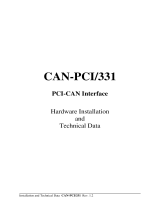 ESD electronic C.2020.04 Hardware Installation And Technical Data
ESD electronic C.2020.04 Hardware Installation And Technical Data
-
hilscher CIFX 50E-CC User manual
-
Pro-face CANopen Master Unit User manual
-
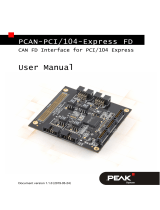 PEAK-System PCAN-PC/104-Express FD Operating instructions
PEAK-System PCAN-PC/104-Express FD Operating instructions
-
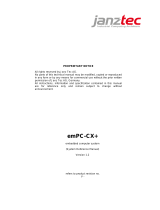 Janz Tec emPC-CX+ System Reference Manual
Janz Tec emPC-CX+ System Reference Manual
-
PEAK PCAN-PCI Express User manual
-
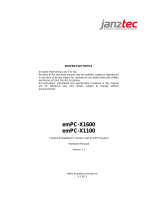 Janz Tec emPC-X1600 User manual
Janz Tec emPC-X1600 User manual
-
PEAK IPEH-003040 User manual
-
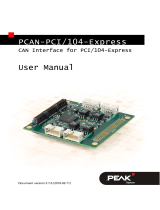 PEAK-System PCAN-PC/104-Express Operating instructions
PEAK-System PCAN-PC/104-Express Operating instructions

































